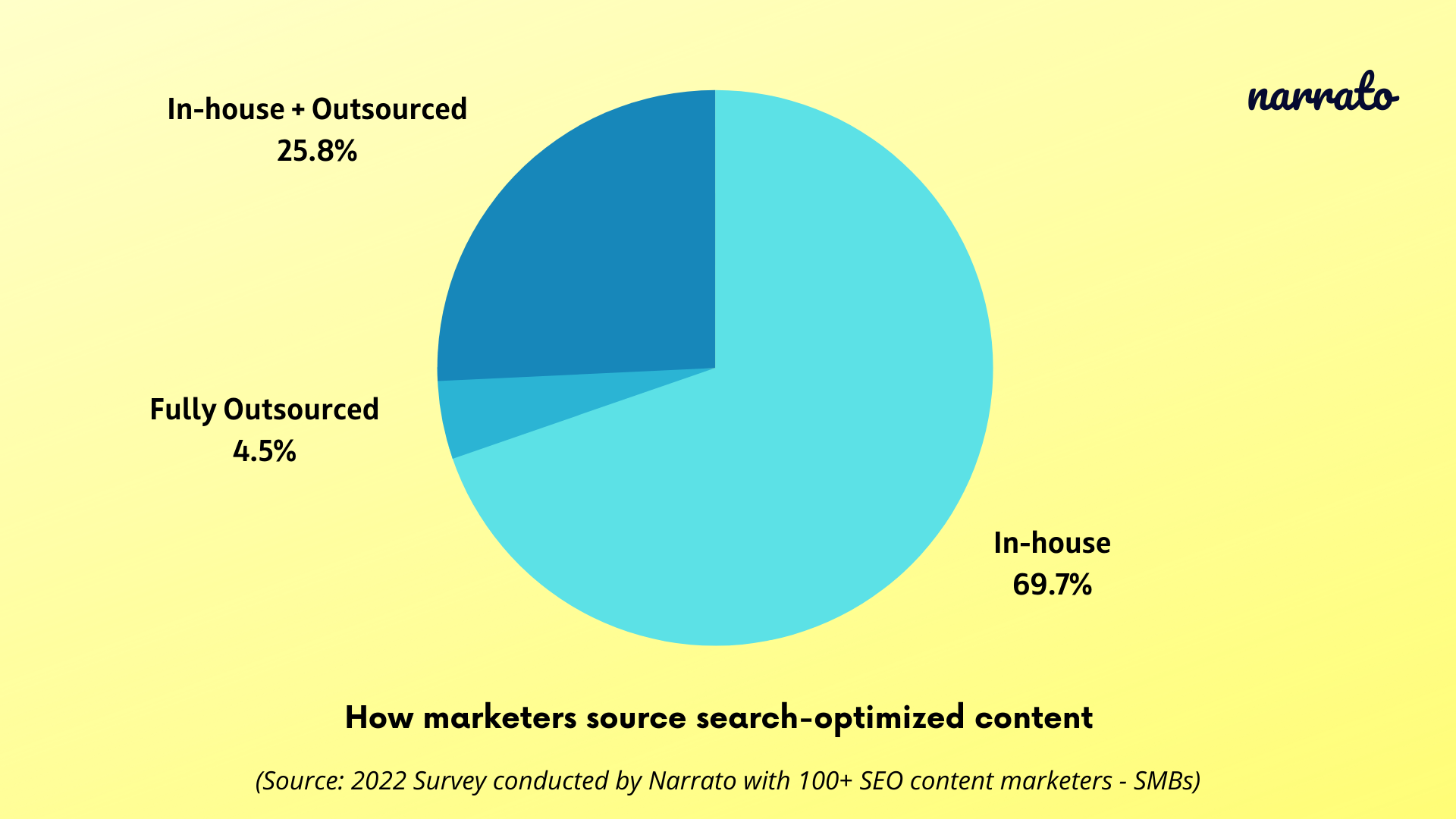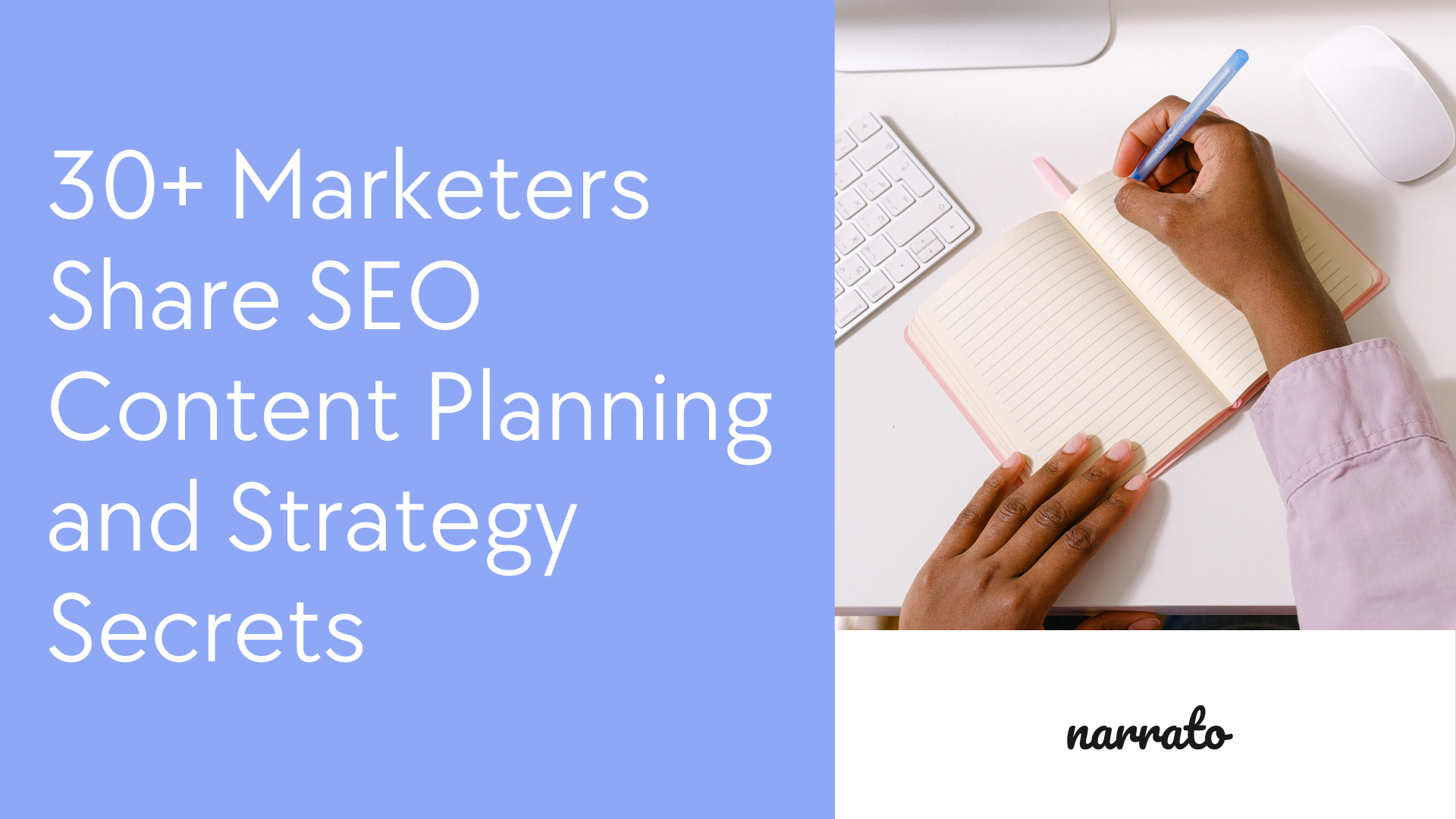When it comes to increasing brand visibility and organic traffic, nothing beats the power of an effective SEO content strategy. SEO content planning is a key area of any content creation process, which may be time- and effort-intensive but cannot be overlooked. Every content marketer or team has their own way of building an effective SEO content strategy that helps them meet their unique content marketing goals. Some rely on traditional approaches while some prefer to speed up the process with SEO planning tools and automation.
We were curious about how businesses ensure that their SEO content marketing efforts pay off. From SEO content planning to measuring content ROI, we wanted to take a closer look at the challenges faced and solutions uncovered by content marketers and business owners from various niches. So we asked them these three questions:
1. What kind of content do you create, and how do you plan for it keeping SEO in mind?
2. How much content do you create, and how do you source it – in-house or outsourced?
3. What’s your biggest challenge w.r.t. optimizing content for SEO and how do you measure content performance/ROI?
TL;DR – Key insights on SEO Content Planning and Strategy
Content planning for SEO and lead generation
- The first step in SEO content planning is keyword research. Marketers use Google Keywords Planner and other top SEO tools like Ahrefs and SEMRush to collect keyword data for their niche.
- Next step is to cluster keywords to identify key themes for content and/or do competitor content research to identify content gaps for content topic prioritization.
- Other factors considered in content SEO planning include search intent, revenue, lead generation and/or traffic potential of the keywords and topics.
- Length, depth, and quality of content matter (a lot!). Deep research, data, great insights, and topical relevance are all key factors in how the content performs. Considerations around whether the content answers key questions about the topic are important too.
- Creating content briefs with SEO in focus ensures the content created is optimized for performance. Tools like Narrato’s AI content briefs generator come in quite handy here.
- Ideally, content should be search engine optimized for multiple mediums such as text, voice, image, and video search.
- Content should be updated frequently to avoid it being outdated as Google is likely to downrank such content.
- Audio-visual content like videos is great for capturing ever-shortening audience attention spans. This type of content often spurs higher engagement.

Here’s a quick video summarizing the 8 points.
Sourcing search engine optimized content
- Majority of content marketers create content in-house, with very few relying entirely on outsourcing.
- A significant section also strikes a fine balance between in-house and outsourced content.

- Content marketers conserve efforts by repurposing existing content, rather than creating new content frequently.
- On average, a small business creates approximately 22 to 23 pieces of content every month.
Content SEO challenges
- The biggest challenge is keeping up with Google’s changing algorithms, such as the shift to mobile-first indexing and many others.
- Marketers are required to constantly monitor content marketing stats and trends, and update their content strategy to appease search engines and target audiences alike.
- The amount of time the SEO planning process demands is another key challenge, particularly for small content teams.
- Finding good writers and content agencies who can deliver both on content quality as well as search engine optimization is tough.
- Keeping content updated and regular content SEO audits pose a significant challenge too.
How Content Performance is Measured?
- Metrics used to measure SEO and content ROI include both engagement and conversion metrics. Metrics chosen are based on content goals.
- Common metrics tracked include organic traffic, time on page, subscriptions, conversions, bounce rates, click-through, and engagement rates (including sharing on social media).
- ROI from SEO planning and execution is slow but certain. It takes an average of 6 to 9 months for marketers to see tangible results from their SEO efforts.
- The most widely used tools for measuring content performance and SEO audits are Google Analytics and Google Search Console.

SEO Content Planning and Strategy – The Interviews
Here’s what 30+ content marketers and business owners shared about their SEO and content process.
1. Andre Oentoro, CEO, Breadnbeyond

1. What kind of content do you create, and how do you plan for it keeping SEO in mind?
I start with a keyword audit. Once I have some keywords that I think can maximize the content visibility, I do content gap analysis by researching competitors’ similar content. From all those already-published content, I can determine if there are any gaps or missed opportunities that could be improved. Using the potential keywords I choose, I fill the gaps so that the content I create can be more in-depth.
Blog posts, infographics, and videos. I always combine written content and visual content for my blog. I make sure I include keywords for text-based content, while for visual content like infographics and fully-customized featured images, I add relevant, accurate alt text and description. And for videos, I rely on tools like Tubics – the tool helps me save a lot of time with their SEO suggestion feature.
2. How much content do you create, and how do you source it – in-house or outsourced?
For social media profiles, we post new content every day. My team and I have a big content project every month for our website. We work on it every day to do research, write, and design. Rather than creating new content day in and day out, I focus more on promoting them and updating the old ones on a regular basis. And for content optimization, we have in-house efforts.
3. What’s your biggest challenge w.r.t. optimizing content for SEO and how do you measure content performance/ROI?
Google algorithm updates might be one of the biggest challenges for me and my team. One day we see our post rank #1 on the SERPs with all the organic efforts we’ve invested in, then the next day we’ll be on the second page. From all those updates and ranking changes, it’s challenging for us to understand what’s affecting what.
We monitor and analyze the performance of individual pieces of content monthly using Google Analytics. I focus on the metrics that my team and I decided what to track in the first place. We use spreadsheets to manually aggregate all the data into a performance dashboard. It gives us an at-a-glance view of our content assets’ performance against our goals.
2. Swapnil Pate, Head of SEO, State of Digital Publishing

1. What kind of content do you create, and how do you plan for it keeping SEO in mind?
We usually work with larger niche content Publishers in Adventure, Lifestyle, Marketing & Adtech. Usually, our content planning process starts during the onboarding phase of a client, where we start with keyword research and then cluster these keywords into topically relevant buckets. Once these buckets are ready, we prioritize the topics considering multiple factors like ranking potential given the client’s current authority, revenue/lead-gen potential, and traffic potential too.
2. How much content do you create, and how do you source it – in-house or outsourced?
Usually, every month we create anywhere between 20 to 50 long-form content pieces(2,000+ words). Since we have a varied mix of News Publishers, Content Publishers & B2B clients from different niches and target countries, we maintain a balance of in-house content for B2B clients and outsourcing some of the content for our News & Publisher clients. Usually, 40% of our content is taken care of in-house and 60% of the content is outsourced as News & Publisher clients have a larger content requirement.
3. What’s your biggest challenge w.r.t. optimizing content for SEO and how do you measure content performance/ROI?
When optimizing content, the biggest challenge is finding the right vendors to outsource because a lot of vendors need to be vetted as per our or client’s expectations and also need to fit in the pricing and writer/language quality.
We measure content performance mainly with the help of custom Dashboards in Data Studio and with the help of tools like Google Search Console, Google Analytics, SEO Testing (mainly for re-optimization pieces to see how re-optimizations helped in getting higher rankings/traffic/new keywords) and SEO tools like Ahrefs or SEMrush.
3. Debbie Vasen, Chief Content Officer, LoveToKnow Media

1. What kind of content do you create, and how do you plan for it keeping SEO in mind?
As the Chief Content Officer for a large digital media company, my business is to create content that our readers love. That includes anything from a standard article to interactive content or a widget. SEO is a critical acquisition channel for our readers. If our content isn’t helpful, then humans won’t want to engage with it. A part of our content marketing strategy is to look at what people go to a search engine for and then create a webpage that meets that readers’ needs better than any other page out there.
2. How much content do you create, and how do you source it – in-house or outsourced?
All our content is in-house, mostly through staff editorial with some freelancers for special projects. We are consistently creating content as it is core to our business model. That process is a constant flow of new content (on and off platform) as well as updating existing. We do this in a high volume (6Kpages and growing each year) while maintaining a quality standard.
3. What’s your biggest challenge w.r.t. optimizing content for SEO and how do you measure content performance/ROI?
The biggest challenge in acquiring digital users from search is the competition. Everyone is in this game. Many times I wonder to myself, how does Google decide which page is truly better? Everyone is competing for keywords. They are all using the same tools, tips and advice. How does a website set itself apart? I ask myself that question every single day. This is the red ocean and there is no magic fairy dust. You have to really put the work in.
That naturally leads to the other side of the equation: measuring content ROI. Another hot topic! At the basic level, you have to determine why you are creating a piece of content and what you hope it can bring for the business. That helps you determine the baseline performance metric (is it pageviews? conversions? engagement?). Then you have to evaluate what it would take to win against that metric and what it will cost in resources to get there. In some cases, it might be more expensive to create the content compared to what you can gain in performance. It is a critical balancing act.
4. Kris Lippi, CEO, iSoldMyHouse

1. What kind of content do you create, and how do you plan for it keeping SEO in mind?
Our team focuses on developing original blog posts that tackle helpful advice and solutions to common pain points of our target audience—homeowners and home buyers. Blog posts are more engaging than product pages; they also contribute to our SEO by helping build our online authority. We also research keywords used by our customers when searching online and incorporate them into our content development.
2. How much content do you create, and how do you source it – in-house or outsourced?
Most of our content develops from outsourced services. We have a team that helps us understand our audience personas more deeply, research the popular keywords and topics they use for their online queries, and craft the articles and visuals to best communicate our expertise in the field.
3. What’s your biggest challenge w.r.t. optimizing content for SEO and how do you measure content performance/ROI?
We have identified content revitalization as a key area for improvement in our SEO efforts. While we understand that updating published posts is just as important as developing fresh content, like most businesses, we neglect to revisit our existing content to keep them free from broken links and update information.
We have resolved to address this by amplifying our content and implementing a content revitalization strategy to protect our site from negative SEO and improve our site visits, engagements, and SERPs rankings for our chosen keywords and topics.
5. Charlene Gervais, Co-Founder, Bluegreen Branding
1. What kind of content do you create, and how do you plan for it keeping SEO in mind?
We are brand strategy consultants working with B2B companies in tech and finance. We create original insight pieces for Brandingmag and for our internal blog. We also publish these insights on LinkedIn. Additionally, we publish free, ungated resources to help CMOs that prefer a “DIY” approach.
For planning, we use the Google Keyword tool to verify a list of about 12 keywords which are, for the most part, also our main services. We have a shared, collaborative Paper doc with those words at the top as a reminder, and also keep a list of content ideas there based on “aha” moments we have when working with our clients on brand strategy engagements. At any given time we are “working” on 2-3 articles.
2. How much content do you create, and how do you source it – in-house or outsourced?
We write all our own pieces. Overall our volume is fairly low and we are focused primarily on quality: about 12 pieces per year.
3. What’s your biggest challenge w.r.t. optimizing content for SEO and how do you measure content performance/ROI?
We write first for readability and usefulness then use a fairly light touch for SEO. We use Yoast for WordPress to ensure we are as optimized as we need to be.
Content performance is measured using Google Analytics. Popular content may be re-published in our newsletter.
We also use our insight pieces as a follow-up in sales calls (in response to a particular pain point expressed by the prospect). This is actually one of the most useful aspects of the library of material we’ve created.
6. Paige Arnof-Fenn, Founder, Mavens & Moguls

1. What kind of content do you create, and how do you plan for it keeping SEO in mind?
I prefer articles and pre-pandemic was a regular blogger for Entrepreneur for ~4 years and then Forbes for ~1 year. Some of my most popular posts were about evergreen topics with a broad appeal based on my experience personally and professionally. To qualify it must be timely and relevant.
Now to present myself as an expert in my industry I post interesting and educational content on LinkedIn by sharing a great article I’ve read recently and to represent myself as a thought leader, I also write articles on LinkedIn.
To make content more attractive and drive conversion it is important to understand not just what or how to purchase a product, experience, or service but also be able to inspire audiences by identifying the underlying motivation.
The key to becoming influential is when you can answer why they do what they do and connect with people on an emotional level. I have been successful for many years using this strategy.
2. How much content do you create, and how do you source it – in-house or outsourced?
In-house. To generate ideas I look at the content calendar to see if there are any natural opportunities based on the season or activities. I keep a running list of topics I get asked about by my clients and other business owners and note when I read or hear about something new I want to explore further – a trend, theme or idea that catches my attention.
If it is an issue that affects me or my business then it is likely to be a topic that impacts others too. Once I decide on an idea to write about I may do research on the topic, talk to people for input and just start typing. If I have a unique perspective to share or any advice I think may help others I get it out there via social media or whatever distribution vehicle makes the most sense.
3. What’s your biggest challenge w.r.t. optimizing content for SEO and how do you measure content performance/ROI?
You must optimize for best results, making sure your content is keyword rich/mobile-friendly/loads quickly/is meaningful is the price of entry. That also happens to be a great foundation for effective SEO. To make SEO even more relevant today content must be optimized for multiple mediums text/voice/image.
Content quality and length matter for rankings. Web pages that contain long high-quality content get more visibility and shares so becoming that trusted source/influencer with timely/helpful answers to questions gets rewarded quickly.
Mobile UX determines your ranking and video grabs attention – live streaming is available on every major social media platform and it is only getting bigger to hook in users with short attention spans. In a mobile-first world, you have less time to grab people, attention spans are shorter than ever. So video will be used even more. Show don’t tell for maximum impact. Rich content drives engagement.
Interactive content marketing makes sites stickier — brands will drive engagement even more with polls/ surveys/ quizzes/ contests/ interactive videos to grab audience attention even quicker.
Using the right keywords for video descriptions/headlines will ensure you do better in searches too. AI-powered chatbots cut costs and convert visitors into leads by encouraging themed content to answer FAQs with voice search friendly semantic keyword phrases.
To improve ROI there are opportunities to repurpose/refresh/reuse content everywhere. It does not take much time to repackage articles that contain outdated information or update your keywords, the possibilities are endless and pay off quickly with increased traffic and engagement.
Blogging is a big responsibility, you have to have a constant stream of fresh content to keep it active and interesting. Given my other responsibilities as an entrepreneur, I get a lot more bang for my buck by making smart comments on popular blogs and then including a link back to my site so they can learn more about me if they are interested.
Instead of trying to start your own blog or newsletter, try contributing regularly to existing high-traffic blogs in your industry or newsletters of like-minded organizations reaching the same target audience as you. Make sure you put your URL or contact info on it so they can find you and follow up.
You do not need to blog or be on all social media platforms but make sure you are active on the ones where you are. If your customers do not use Facebook, Twitter, or Instagram to find you then you do not need to make them a priority. For many professional service businesses like mine, LinkedIn matters the most and it is easy to publish there.
7. Sam Speller, Founder, Kenko Matcha

1. What kind of content do you create, and how do you plan for it keeping SEO in mind?
I create specialty tea content that is designed to be shared. I write it in a way that’s meant to be easily consumed and also easily shared so that my audience can help me spread the word about my brand and products.
I always keep SEO in mind when I’m writing. That means I’m thinking about how people will find my content, and how they’ll share it once they do. I also make sure that the things I write are engaging and interesting—and sometimes funny!—so that people will want to share them.
The most important thing you can do is just keep writing! The more you do it, the better you’ll get at it (and the more people will want to share your content).
2. How much content do you create, and how do you source it – in-house or outsourced?
I create and publish about twenty pieces of long-form content each month, including blog posts, and guest posts. I also schedule about five Twitter posts for each week, and another five per week for Instagram.
All of my SEO content creation is done in-house.
3. What’s your biggest challenge w.r.t. optimizing content for SEO and how do you measure content performance/ROI?
I think my biggest challenge with optimizing content for SEO is that it’s an ongoing process. You can’t just do it once and call it a day. You need to keep up with the trends in your industry, as well as with what Google is looking for in order to rank your site.
And that means you have to be willing to invest time and energy into doing research about what works, what doesn’t work, and what’s changing.
How I Measure Content Performance/ROI – I rely on engagement metrics to measure my content’s performance. Some of the engagement metrics I look at include click-through rates on my social media posts, comments/likes on my blog posts, bounce rate, and how much time users spend on an individual page on my site.
8. Kristien Matelski, Content Manager, Vizion Interactive
1. What kind of content do you create, and how do you plan for it keeping SEO in mind?
We create blog posts, e-guides, website copy, and pretty much whatever type of content you can think of! SEO is always a big part of our content planning and goes into the research phase with keyword research, which then goes into the content brief, and is reviewed at the end for SEO, which includes keyword review, meta data, internal linking, etc.
2. How much content do you create, and how do you source it – in-house or outsourced?
We create content for ourselves, and also for our clients, since we’re an agency. For subjects that we’re SMEs (Subject Matter Experts) in, we write ourselves, and for subjects we are not, we outsource.
3. What’s your biggest challenge w.r.t. optimizing content for SEO and how do you measure content performance/ROI?
It can be challenging when you’re creating content for a client on a subject that you know very little about. In these instances, it’s that much more important to effectively communicate back and forth with the client on keywords, search intent, etc. to make sure that the content piece effectively does what it was intended to do.
When it comes to running SEO audits or measuring content performance/ROI, it’s important to have proper tracking in place such as URL tagging and Google Analytics goals so that you can easily pull your desired metrics from your campaign. The success/ROI of the campaign is going to depend on what the goals are, but if it’s something like # of leads generated, then that’s easy to pull from GA and determine whether the campaign was a success or not.
9. Chandler Bolt, Founder, Self Publishing School

1. What kind of content do you create, and how do you plan for it keeping SEO in mind?
We create blog posts and videos that help people to write and publish books. They might do this for the love of writing or to boost their profile and build their business. No matter what their reason is, our content aims to provide them with everything they need to be successful. We research topics, keywords, and headings to include by carrying out SEO research using Ahrefs.
2. How much content do you create, and how do you source it – in-house or outsourced?
We create over 30 pieces of content each month, and we have a mixture of internal and external content creators to draw upon.
3. What’s your biggest challenge w.r.t. optimizing content for SEO and how do you measure content performance/ROI?
Our biggest challenge is to maintain our rankings for competitive terms. In terms of measuring performance, we like to see content attracting traffic, eventually leading to people signing up to our mailing list or downloading one of our free resources.
10. Jo Barnes, Owner, Your Lifestyle Business

1. What kind of content do you create, and how do you plan for it keeping SEO in mind?
Intense keyword research – If you are starting with a new site, until you have built up trust and authority in the eyes of Google it’s important to create content that targets low competition keywords. There is little point in spending time and money creating amazing content for a keyword you have no chance of ranking for. However, once you have built up your domain authority you can start to target the more competitive terms with higher search volumes.
Create a content plan based around silos – I pick a main key phrase I want to rank for and research 5 – 10 related key phrases I can create content around. Each silo is a separate project.
Write and publish content – The more keyword-optimized content you create, the more keywords you can start to accumulate in the Google SERPs, and the quicker your traffic will grow.
2. How much content do you create, and how do you source it – in-house or outsourced?
When I started a couple of years ago I was only publishing once a week, nowadays I try to publish 2000+ word posts, 3 – 5 times a week. I started with just me, but now have a writer on board also.
3. What’s your biggest challenge w.r.t. optimizing content for SEO and how do you measure content performance/ROI?
Link building. The biggest challenge with growing a website is building trust and authority. You need a lot of external links to grow your domain authority and have a chance to rank for more competitive keywords, but link building is time-consuming, competitive, and expensive (you can outsource link building)! I respond to HAROs daily, do some guest posting as opportunities arise, and outsource link-building collaborations and content syndication, etc. To measure my performance I use Google Search Console, Google Analytics, and Ahrefs.

11. Richard Barker, Marketing Executive, Clarion Security Systems

1. What kind of content do you create, and how do you plan for it keeping SEO in mind?
I always look to keep content topically relevant. So in our industry where we offer security systems, I try to keep the theme to security and related topics. Essentially I look to build topical clusters around a core niche of subjects. So recently I created an article about CCTV numbers in London which really goes into detail on the subject, features data from 34 London councils, and shows a clear methodology for the final estimate.
Now this article ranks for a range of London-based topics about the number of CCTV cameras in the capital, even outranking an article that has links from the New York Times and others. Why? I would like to think that it is up-to-date, has a wide range of data points, and covers it all! So when creating content, look to make sure there is search intent (are people looking for it on Google? Does it really cover the topic? And have you included data? This is vital if you want journalists to pick it up as they look for stats). I tend to focus on long-form content that fully answers a searcher’s query as I have found this works the best on Google.
2. How much content do you create, and how do you source it – in-house or outsourced?
I tend to write two long-form articles per month, as I have to handle a lot of the marketing at the company. My advice would be to focus on quality rather than quantity – in the end, you will win against those that do not.
3. What’s your biggest challenge w.r.t. optimizing content for SEO and how do you measure content performance/ROI?
I tend to follow a guide that I created which allows me to ensure I have ticked most of the boxes when it comes to optimizing a post for SEO. Some tips are:
- Make sure you only have one H1 tag
- Use H2 / H3 tags throughout the post to make the article easy to read
- Use small paragraphs, rather than longer ones – I find that these are easier to read
- Check internal and external links
- Make sure images are used throughout (if you can create your own these are great to help build links if other websites use them)
- Use an SEO focused meta title, description, and URL slug
- Ensure that I have included answers to Googles People Also Asked question, this will give the article more relevance
11. Luisa Zhou, Founder, LuisaZhou.com

1. What kind of content do you create, and how do you plan for it keeping SEO in mind?
We create blog posts, mainly with our SEO content strategy in mind. Our blog posts are long-form posts and really valuable because that’s what drives traffic in my niche. We have a process where we decide on keywords we want to hit each month and then we use those keywords to create content that we optimize with SEO in mind.
2. How much content do you create, and how do you source it – in-house or outsourced?
We create all our content in-house. I have a small SEO team that, together with me and with the help of my existing material, creates blog content and takes care of publishing and promoting it.
3. What’s your biggest challenge w.r.t. optimizing content for SEO and how do you measure content performance/ROI?
Our content performs well in terms of SEO, but I would say that the primary challenge is to keep it up to date and competitive. AKA ensuring at regular intervals that it’s top-notch and timely for readers and Google.
12. Tanya Zhang, Co-Founder, Nimble Made

1. What kind of content do you create, and how do you plan for it keeping SEO in mind?
I create blog posts, Instagram ads, and related media videos related to men’s wear and fashion for Nimble Made, a brand dedicated to creating slim-fit dress shirts without the tailor. In order to create a good SEO-backed blog post with high engagement, it requires a lot of planning and research into the current market. I plan by researching current keywords and other content-related trends to ensure that I can optimize my information.
2. How much content do you create, and how do you source it – in-house or outsourced?
I try to create as much content that applies to our brand as possible. Understanding that it takes time for SEO to have an impact, you need to have enough on hand to adjust to a market possibly 6 months in the future. My SEO is currently in-house.
3. What’s your biggest challenge w.r.t. optimizing content for SEO and how do you measure content performance/ROI?
The biggest challenge with optimizing content for SEO is the length of time it takes to see results. Naturally, there isn’t an instant return so a blog or a post might take a couple of weeks to months to see relevant content performance data. This also means that updating content can also be difficult. You need to do enough research and data analysis to ensure that your content is providing valuable returns. I measure content performance / ROI through click rates from a certain blog post to Nimble Made and then actual conversion to sales.
13. Violeta Bojkovska, Head of Content, Shortlister

1. What kind of content do you create, and how do you plan for it keeping SEO in mind?
Since Shortlister operates in the wellness and HR space, the majority of our content is centered around employee experience.
We try to cover important issues like the labor shortage, the great resignation, and mental health in the workplace by writing the articles in a thought leadership format. And as a B2B company, we must plan around upcoming trends in the industry and specifically targeted long-tail keywords.
Ranking any piece of content without a solid SEO strategy hasn’t been an option for almost a decade. Everything that goes into creating an article, from keyword research to content promotion to on-site optimization, is essential.
2. How much content do you create, and how do you source it – in-house or outsourced?
We publish two to three pieces of content per week and around five to six thought leadership articles per month. And most of our content is long format. All of it is written by our in-house content team.
3. What’s your biggest challenge w.r.t. optimizing content for SEO and how do you measure content performance/ROI?
My biggest challenge is the longevity and the amount of work that goes into the content preparation itself before the writing even starts.
Every content brief is created according to a detailed SERP analysis. Most of the time, that includes main, secondary and LSI keywords, internal and external backlinks, and a basic content structure prepared in advance per our SEO findings.
The way we measure content performance has one simple side: the classic traffic and keyword rankings. And one more complicated side, which is not that easy to estimate since it’s not pure data: the feedback from our clients and the brand recognition.
14. Ankur Goyal, Head of Growth, Coterie

1. What kind of content do you create, and how do you plan for it keeping SEO in mind?
Our brand content focuses on lifestyles. We want to support parents holistically, and while we primarily accomplish this through our products, we capitalize on the opportunity to present information and support in our content.
2. How much content do you create, and how do you source it – in-house or outsourced?
We post on social media almost every day. We include user-generated content to show users how our customers use our products and welcome them into our community. We also focus on authenticity, letting users know how we make and distribute our products, where we source ingredients from, and what it’s like to work at Coterie.
3. What’s your biggest challenge w.r.t. optimizing content for SEO and how do you measure content performance/ROI?
We measure our content performance by analyzing social media engagement, subscriptions, and conversion metrics.
15. Shane McEvoy, MD, Flycast Media

1. What kind of content do you create, and how do you plan for it keeping SEO in mind?
We create quite a lot of “how-to” content, things like how to improve the SEO of your WordPress site or how to use landing pages to improve Google ads conversions.
We generally do quite a lot of keyword research using tools like Ahrefs to look into traffic and keyword difficulty, and then we build a content plan for the next 6/8 months.
2. How much content do you create, and how do you source it – in-house or outsourced?
We probably create about two different blog posts a month along with some PDF guides. All the planning is done in-house but we have specific writers for ourselves and different ones for clients dependent on the industry that
they are in.
3. What’s your biggest challenge w.r.t. optimizing content for SEO and how do you measure content performance/ROI?
I think the biggest challenge we face is the fact that we are a digital agency and everybody in our space is probably pretty good at what they do so the competition is quite a lot harder than it is for our clients. We measure ROI in two different ways, overall traffic improvement to site as well as how many of the blog posts are the first entry point for a user.
16. Lisa Richards, CEO, The Candida Diet

1. What kind of content do you create, and how do you plan for it keeping SEO in mind?
I create content that is focused on the health and nutrition industry. I plan for my content to be optimized for SEO by using a keyword strategy, which means I use keywords in my blog posts and social media posts that are relevant to my target audience’s search habits. I’ve also found that it helps to have a consistent tone and style across all of your content, so people know what to expect when they come back for more.
2. How much content do you create, and how do you source it – in-house or outsourced?
Usually, we create about three blog posts per month, as well as four Twitter posts each week. All the content we create is in-house, and have a dedicated content writer that works for my brand on a full-time basis.
3. What’s your biggest challenge w.r.t. optimizing content for SEO and how do you measure content performance/ROI?
It’s easy to get caught up in all the little details when you’re writing something for SEO purposes—but don’t let them get in your way! Just keep things simple, focus on what matters most (your topic and audience), and write from there! I use Google Analytics to see how long people are staying on each page of my site. If they’re not staying long enough, then I know that my content isn’t working for them—it’s not answering their questions, or telling them about things they need to know about.
17. Mohamed Natheem, SEO Consultant, Mailmodo
1. What kind of content do you create, and how do you plan for it keeping SEO in mind?
“Here are the questions that I ask while creating a content plan:
1. Identify who I need to reach with the content
2. How the content will help them?
3. What type of content is needed?
4. What is the intent of the article?
5. How do we differ from others in the SERP?
6. Length of the content needed.
7. Who will take care of what?
We create articles for our blog. Here’s how we do SEO for it,
1. We do a content gap analysis.
2. Pick a target keyword to write an article based on search volume.
3. Google the focus keyword to understand the intent and type of article to create.
4. Find secondary keywords to weave into the content.
5. Find the recommended content length for the article.
6. Optimize the title, description, and URL of the page. Target keywords in all these would be preferable.
7. Suggest headers starting from the H1 tag. Use the target keyword in at least one header.
8. Optimize body content for readability.
9. Pick anchor texts and add relevant internal links.
10. Have we included images to make the content easier to scan? And whether relevant alt and title tags are added to the images.
11. Check whether the target keyword activates the featured snippet in the SERP. If there’s a featured snippet, then optimize the content for it
12. After publishing the article, add links to the new article from relevant older articles.
2. How much content do you create, and how do you source it – in-house or outsourced?
We create around 15 to 20 articles per week and we do it all using our in-house writers.
3. What’s your biggest challenge w.r.t. optimizing content for SEO and how do you measure content performance/ROI?
Content distribution is the hardest part than optimizing content for SEO.
Content success depends on the individual article goals. For example, if a goal for an article is to educate customers and create brand awareness, then we measure organic traffic, average time on page, and bounce rate.
18. Charlotte Chamberlain, Content Strategist, Tao Digital Marketing

1. What kind of content do you create, and how do you plan for it keeping SEO in mind?
We create a wide variety of content at Tao Digital, the main three being in-depth guides, service pages and PR content.
We keep SEO in mind with all content we create. Content ideas will come from our initial research from Google Search Console and Ahrefs. We occasionally refer to People Also Ask, Answer the Public and the SERP (Search Engine Results Page) for further questions to answer in our guides. I always keep a list of keywords up whilst writing content to make sure I’m including them enough to rank.
Our PR efforts, such as digital PR campaigns and guest blogs, will also be created with SEO in mind every step of the way. They will always be relevant to the client’s main service offering, or perhaps a specific branch of the offering if we are looking to build authority to one service page. Anchor text is determined by combining relevancy with search term data.
2. How much content do you create, and how do you source it – in-house or outsourced?
We’re primarily a B2B search marketing agency, so all of the content we create for our clients is created in-house. We create just over sixty pieces of content per month between fifteen clients. Typically this is broken down into:
- 25 PR pieces, including features, PR campaigns, and guest blogs
- 35 pieces of content – four each for our biggest clients, typically two for the medium/smaller sized clients
This is done between a team of three people – myself, our PR exec, and one other member of the team who is split across both content and PR. The rest of our total team of seven focuses on web development and technical SEO.
3. What’s your biggest challenge w.r.t. optimizing content for SEO and how do you measure content performance/ROI?
The biggest challenge for us is aligning SEO goals with the client’s goals. We can certainly optimize content for the best keywords and searches, but they also have to be relevant to the products or services that the client offers. We’ve had situations before where we have built fully fleshed-out content plans, but when we send them to the client, they don’t want to go after the biggest search terms in their industry as they may not want to offer this as a service for numerous reasons.
In terms of measuring performance, again we use Ahrefs and Google Search Console. We are starting to combine all of our data into Google Data Studio so that it’s easy to view in a single interface. Not only does this help with measuring performance, it massively helps with client reporting too. Domain rating, impressions, clicks, trends, and lead generation can be viewed in one place.
19. James Parkinson, Head of Marketing, Personnel Checks

1. What kind of content do you create, and how do you plan for it keeping SEO in mind?
We are firm believers that by building a relationship with our readers we will help them connect with us and trust us. For that reason, we create a mixture of informative content but like to add a personal tone of voice. We don’t want to come across as stuffy and serious but more like a knowledgeable friend that you can rely on. Writing this kind of content can easily be repurposed across different platforms such as our blog, social media sites, and newsletters. This is beneficial to our SEO performance as it is an efficient way of appearing in more places and generating more links and traffic.
2. How much content do you create, and how do you source it – in-house or outsourced?
All of our content is written in-house. We have a team of experts that we know can convey the legal side of our messaging in the right communication style. We create frequent new articles but also try to repurpose wherever we can.
3. What’s your biggest challenge w.r.t. optimizing content for SEO and how do you measure content performance/ROI?
The biggest challenge for optimizing our content for SEO is ensuring all of the information is up to date and factually correct. As Google gets more intelligent and can tell the difference between poor and high-quality content we want to ensure we are always at the pinnacle of standards and can’t be punished for false or outdated content.
We use a mixture of Google Analytics and Semrush to make sure our content is visible to the right audience, driving the right kind of traffic and ultimately more transactions.
20. Gosia Hytry, Head of Content, Spacelift
1. What kind of content do you create, and how do you plan for it keeping SEO in mind?
Our content focuses on educating communities in our field to provide unbiased and high-quality information. It mainly consists of articles on our blog, and we pay the most attention to the keyword density of the content created to keep SEO in mind.
2. How much content do you create, and how do you source it – in-house or outsourced?
We share 4-6 articles per month, usually created in-house, though they can be outsourced depending on the topic.
3. What’s your biggest challenge w.r.t. optimizing content for SEO and how do you measure content performance/ROI?
The biggest challenge for optimizing our content is ensuring we don’t compromise content quality for SEO. Our primary focus is satisfying the user intent with each article; however, it may not be easy to do so when you try to outrank your competitors.
21. Natalia Brzezinska, Marketing Manager, PhotoAiD
1. What kind of content do you create, and how do you plan for it keeping SEO in mind?
One of the pieces of content we create is blog posts. We optimize our posts by conducting keyword research and using them strategically. That means avoiding keyword stuffing, using proper keywords, and adding them to the title tag, headers, body, URL, and meta description, including clear CTA, and implementing on-site and off-site strategies.
2. How much content do you create, and how do you source it – in-house or outsourced?
We have an in-house content team that creates content regularly.
3. What’s your biggest challenge w.r.t. optimizing content for SEO and how do you measure content performance/ROI?
When optimizing content for SEO, it is crucial to avoid a thin content penalty. It doesn’t necessarily refer to the content’s length — instead, it relates to its value. Therefore, it is essential to create always unique content that adds value. The key SEO content creation metrics are site traffic, on-site time, returning visitors, and conversion rate.
22. Richard Chen, Co-Founder, Notta

1. What kind of content do you create, and how do you plan for it keeping SEO in mind?
We use powerful words to grab user attention. The content is mostly actionable or highly suggestive so they have a high chance of engagement. We use customer feedback for Notta to act as a public example of our user satisfaction and great services. This reduces our bounce rates and increases authority which helps in our SEO.
2. How much content do you create, and how do you source it – in-house or outsourced?
We have an in-house marketing team that is responsible to take regular customer feedback and use them for our SEO campaigns.
3. What’s your biggest challenge w.r.t. optimizing content for SEO and how do you measure content performance/ROI?
The goal is to rank higher on the search results. Having our website rank higher on search engines is the return we track against our investments.
23. Geoff Cudd, Owner, Don’t Do It Yourself

1. What kind of content do you create, and how do you plan for it keeping SEO in mind?
I create content for a variety of sites about a variety of topics, primarily subjects surrounding digital marketing and cars.
I use resources that help me track SEO keywords, then build silos of content around the top keywords related to subjects that are relevant to the sites. For instance, if I find that SMS marketing is a popular keyphrase, I create multiple different content ideas with keywords that are searched under that umbrella.
2. How much content do you create, and how do you source it – in-house or outsourced?
I create as much content as I can using both in-house resources and outsourced. Content management and some subjects I trust my full-time employees with, while the rest, I outsource to freelancers or companies that provide monthly services. I’ve even experimented with AI content creation.
3. What’s your biggest challenge w.r.t. optimizing content for SEO and how do you measure content performance/ROI?
My biggest challenge for optimizing SEO is prioritizing what to work on first, and also the ever-changing algorithm that search engines use as well as keeping up with new trends in SEO. I measure content performance by tracking how much traffic a given post brings to my site as well as checking to see where my posts rank when I search for relevant topics on my own.
24. Adelle Archer, CEO, Eterneva

1. What kind of content do you create, and how do you plan for it keeping SEO in mind?
Our business deals with people going through very difficult and emotional times, so the purpose of our content is not to sell a product but to offer them support through the process, which is why we focus on expert opinions. Our customers want content rich in information in which the sources it references are of the most respected in their fields.
2. How much content do you create, and how do you source it – in-house or outsourced?
Through regular weekly blog posts, newsletters, and quarterly webinars, we couple those information-rich sources with keywords and long-tail phrases that drive our SEO, and make it easy for those seeking this type of specialized content, simple for them to find.
The combination of our services, coupled with the expertise of others, accomplishes both goals of creating a support apparatus while operating as the main driver of our search engine optimization.
25. Cody Candee, Founder, Bounce

1. What kind of content do you create, and how do you plan for it keeping SEO in mind?
By telling the stories of our customers, business, and employees, in newsletters, blogs, and on social media platforms, we were able to attract an audience, and the high sharing rates of these promotions, helped advance our SEO efforts. In addition, storytelling allows us to create a continuous thread through our entire campaign, further enhancing our SEO efforts, while cementing our brand and expertise within our market space.
3. What’s your biggest challenge w.r.t. optimizing content for SEO and how do you measure content performance/ROI?
Our business is part of a niche industry, meaning that we do not have a physical product to display, so our biggest challenge was to create content that would attract an audience as well as drive our SEO, and we found that through narrative marketing.
Studies have shown that narrative or storytelling promotions has engagement rates that are nearly ten times higher than short-form promotions, and even more importantly, has sharing rates of up to 20%.

26. Jeannie Assimos, Head of SEO, Way
1. What kind of content do you create, and how do you plan for it keeping SEO in mind?
Planning is a big part of SEO, as a good SEO content strategy incorporates content hierarchy and interlinking; it’s important to think through head topics and subtopics and how they fit within URL hierarchy with interlinking. I typically do keyword and topic research first, map out the hierarchy of those topics, and then start creating the content.
We plan the creation of blogs and landing pages, as well as supplemental content like videos and infographics that are used to gain backlinks and create sharable assets. Videos wrapped in schema also help optimize YouTube and website growth.
2. How much content do you create, and how do you source it – in-house or outsourced?
We create hundreds of pages of content a month across our blog and landing pages. We have a growing in-house team of content writers and a few special guest writers for thought leadership pieces.
27. Shawn Ryder, President, Shawn Ryder Digital

1. What kind of content do you create, and how do you plan for it keeping SEO in mind?
I work with automotive retail dealerships to develop content for their websites. When it comes to SEO important to focus on the local market for dealers. While dealers want traffic and can sell cars nationwide, most of the people looking at their site are in the local market. Now using SEO can certainly expand that ‘local’ for them from outside of their location to include close locations and why travel to their dealership is beneficial.
We create blog posts on a regular basis and update pages on the site to differentiate from others in the market. Obviously would be seasonal content for the service department and also new models that are coming out from the manufacturer.
2. How much content do you create, and how do you source it – in-house or outsourced?
For content development we keep it in-house – automotive can be very specific and need to have quality in place for content. In terms of measuring, the obvious is watching Analytics and Google Console but also tracking the actual leads that are generated for the client dealership. At the end of the day, they want more folks looking at their virtual showroom but need people that are interested in vehicles or services they offer to buyers.
28. Jordan Fabel, Founder, ApprovedCourse

1. What kind of content do you create, and how do you plan for it keeping SEO in mind?
We primarily create articles about a huge variety of professions, detailing the various paths people can take to become qualified, and help them to find the right course for their aspirations. We’re a reader-supported website, so we do include affiliate links, and we also have other SEO campaigns ongoing. This means we’ve got to carefully consider which kind of articles and links we’re posting, making sure we’re reaching our objectives while maintaining our marketing commitments and building a strong customer base.
2. How much content do you create, and how do you source it – in-house or outsourced?
We’re creating content all the time, and generally look to release a handful of articles each month. All of our content is sourced in-house by our small remote team.
29. Mark Mcshane, MD, Skills Training Group

1. What kind of content do you create, and how do you plan for it keeping SEO in mind?
When it comes to producing content for SEO, we focus on identifying and targeting long-tail keywords with high search volume and low competition. This is a winning formula for us. Typically, these keywords come in the form of questions. We identify several different keyword variants and build each article around these. Usually, we include the keywords in the H2 and H3 subheaders. We always front-load the target keyword in the title for clear optimization.
30. Kate Zhang, Founder, Kate Backdrop

1. What kind of content do you create, and how do you plan for it keeping SEO in mind?
Since our company is focused on backdrops, our content is visual. We include keywords in our photo captions and descriptions so that our photos come up when people search for those keywords. For example, if someone searches for red carpet event backdrops, we want one of our photos to come up. We also do blog posts, social media posts, and mail marketing. For all of these, we plan our content around keywords that we want to rank for. We also make sure to include calls to action and links back to our website so people can learn more about our products and services.
2. How much content do you create, and how do you source it – in-house or outsourced?
In-house. We have a team of in-house writers, designers, and photographers who create most of our content. Our content is mainly focused on backdrops and event planning, so we have a lot of expertise in-house. We don’t outsource much content, but we occasionally hire freelance writers to help us with specific topics.
3. What’s your biggest challenge w.r.t. optimizing content for SEO and how do you measure content performance/ROI?
The biggest challenge we face with optimizing content for SEO is making sure our content is high quality and engaging. We want people not only to read our content but also to share it and link to it. We measure content performance by looking at engagement metrics like shares, likes, comments, and website traffic and conversions.
31. Alex Savy, Founder, Sleepingocean

1. What kind of content do you create, and how do you plan for it keeping SEO in mind?
We are a group of sleep health professionals, and we create content about how individuals can improve their sleep.
While planning for content to publish on our website, we carry out research first. This research is to help determine what the market keyword for the content we wish to post would be. Usually, we use Ahrefs Keywords Explorer and Google keyword planner as research tools. Afterward, we review similar content on the SERP (search engine results page) to help us plan better.
2. How much content do you create, and how do you source it – in-house or outsourced?
We publish content twice a week, ranging from about 1200 to 1500 words. This is to ensure that the content is correctly optimized.
We outsource content to remote content writers but give them guidelines to keep them in check. Additionally, the editorial team works on each writing piece. This ensures strict adherence to the guidelines.
3. What’s your biggest challenge w.r.t. optimizing content for SEO and how do you measure content performance/ROI?
The biggest challenge with optimizing content for SEO is Google. Google constantly rolls out updates to its search algorithm, consequently hurting content ranking.
We measure content performance through digital marketing dashboards such as Google Analytics. This tool provides us with detailed information on our number of visitors and page views. It also provides us with the rate at which people engage in our content.
32. Yuvi Alpert, Founder, Noemie

3. What’s your biggest challenge w.r.t. optimizing content for SEO and how do you measure content performance/ROI?
One of the greatest changes to SEO happened quite recently and with little notice, and that was the altering of Google algorithms, presenting many businesses, including ourselves, to make massive changes to our mobile websites in order to optimize our search engine impact. Google algorithms moved to a mobile text crawl first policy, meaning that it will check mobile websites before the general websites that are associated with standard computers.
Businesses now must focus on optimizing or building mobile sites in which their text, images and script are designed to touch on these new Google standards. For businesses like ours, which are heavily dependent on visuals, image quality must be maintained, yet download speeds cannot be slowed. As the use of mobile device shopping continues to grow, so will the challenge of maintaining mobile websites for SEO purposes.
33. Chris Mitchell, CEO, Intelus Agency

1. What kind of content do you create, and how do you plan for it keeping SEO in mind?
SEO is at the very heart of our content marketing strategy and almost every piece of content starts with a well-thought-out, keyword-optimized blog post.
2. How much content do you create, and how do you source it – in-house or outsourced?
We work with a partner who does the keyword research and writing, then we publish it in-house and get to work repurposing the blog posts into various formats like infographics, slideshows, videos, and quotes, which we distribute primarily on LinkedIn plus other sources.
3. What’s your biggest challenge w.r.t. optimizing content for SEO and how do you measure content performance/ROI?
At one point, we had challenges meeting deadlines and we had a lot of back and forth revisions which wasted time. To solve the problem, we built an automated workflow, which combines project management and collaboration tools.
When a new article is ready to repurpose, a new task is created in one of these project management tools to begin the process of making the blog post into other pieces of micro-content.
Once our content creators create the content, it goes into a workflow automation platform where a series of automation guide the content through the whole process.
Each time the status field is updated such as editor review, manager review, etc, the next person in line is notified on Slack, and the whole content production process moves along efficiently.
We’ve been able to reduce our SEO content creation times by as much as 60% using this process, and we’ve also reduced the margin of error significantly.
To measure the effectiveness of our content, we use LinkedIn, Shield Analytics, and Google Analytics to filter and understand which posts generate the best engagement, views, website clicks, and leads.
34. Steven Walker, CEO, Spylix

1. What kind of content do you create, and how do you plan for it keeping SEO in mind?
Most of the time, we focus on informative content for the user. The reason why I make sure our content is informative is that people don’t read further when they don’t get any related information in the content. Apart from that, we also focus on the hook that can attract the reader to dig more inside the article or blog. Moreover, SEO works parallel to the content. Our SEO team regularly focuses on the keywords that are being searched related to the content we are giving. And they make sure to provide those keywords to the writers that can add them to their writing.
2. How much content do you create, and how do you source it – in-house or outsourced?
We create at least 30 articles, 7 to 10 blogs & 5 guest posts per week. And our employees create it. We don’t hire freelancers till now.
3. What’s your biggest challenge w.r.t. optimizing content for SEO and how do you measure content performance/ROI?
The biggest challenge is to adjust those keywords smoothly in writing. Often, it happens some specific keywords do not get comfortable with the writing of a person & create some non-worthy content for the users. We are still working on it. It is all on the shoulder of the writers, so we are making sure to provide them guidelines & training to adjust those keywords smoothly in their writing. We measure all this with the help of a content writing team leader & Grammarly.
35. Mitchell Elworthy, Founder, The Lighting Outlet
1. What kind of content do you create, and how do you plan for it keeping SEO in mind?
Our main sources of SEO content are informative blogs, news, and online product updates.
2. How much content do you create, and how do you source it – in-house or outsourced?
We source a combination of in-house and outsider SEO content creators after deciding on specific campaigns every quarter.
3. What’s your biggest challenge w.r.t. optimizing content for SEO and how do you measure content performance/ROI?
In our type of eCommerce business, it all depends on seasonal demands. As we are an international company this keeps our website attuned to various problems, needs and trends happening around the globe, in which our company can contribute solutions specifically targetted for those regions.
Our biggest challenge is updating products that are affected by supply chains so as not to disappoint customers who have clicked on our optimized search results. As we are a large company selling hundreds of brands and products, we have to keep alternative product options open for customers and make them just as attractive.
36. Matthew Post, Co-Founder, SEM Dynamics
1. What kind of content do you create, and how do you plan for it keeping SEO in mind?
When creating content to improve a site’s SEO strategy, we focus on researching what topics and questions are for searched for by our intended audience. Our SEOs heavily outline the topics to be discussed and heading to use in the article with sample articles that can be referenced for style and brainstorming. These outlines are first created around the correlation of similar articles ranking well for the search terms we are targetting. Along with outlining and producing the content, we brainstorm how we can create supporting articles that this article can internally link to. We then expand and refine each article to create a more relevant and in-depth piece of content.
2. How much content do you create, and how do you source it – in-house or outsourced?
We work with both in-house and outsourced writers.
3. What’s your biggest challenge w.r.t. optimizing content for SEO and how do you measure content performance/ROI?
Getting client buy-in is one of only a few roadblocks that we face when deploying an SEO content strategy. Using organic traffic as the primary KPI with the addition of time on page and lead conversions as secondary metrics, we can show the value that this strategy brings to a business.
37. Natasha Rei, Digital Marketing Manager, Explainerd

1. What kind of content do you create, and how do you plan for it keeping SEO in mind?
Keyword research is a must. When planning new content for our blog, optimizing SEO is our top priority. Great SEO will help with incoming traffic as well as content ranking on Google search results.
Make sure to check competitors’ content and analyze what you can improve from it, SEO-wise. You can use the skyscraper technique to boost your content and improve the SEO part of it.
Mostly, we focus on blog posts and infographics. For the article, we always analyze existing top content and learn how we can improve from it. Such strategies include optimizing for on-page SEO, and adding more thorough posts can help with content discovery. For the infographic, we use the current trend and add popular tags so everyone can find our content easily.
2. How much content do you create, and how do you source it – in-house or outsourced?
We consistently post a weekly article on our blog, covering our niche and other related topics. But, we have a big campaign project quarterly. We run detailed research every day to prepare for it to go smoothly. All the content production is done in-house as we have top talents who are experts in this area.
3. What’s your biggest challenge w.r.t. optimizing content for SEO and how do you measure content performance/ROI?
We’d say the fast change in trends is one of the biggest obstacles besides the constant-changing Google Algorithm to optimizing our content. At one time, the market is focusing on one thing when a new technology comes in. We sometimes have a hard time adjusting to new trends and craft them as one of our content, e.g., social media features, as we need to learn how they work and help the audience gain more benefits. After all, we are the ones who give tips through the article.
We use tools like Google Analytics and Ahrefs to analyze our content performance. Google Analytics helps us find which content makes the best outcome, such as ROI. Ahrefs helps with the overall page performance as it breaks down to detail if an article drives traffic or has a big bounce rate. These tools are helpful for us to better prepare our next content.
If you’re interested in reading more expert interviews on content marketing and related topics, here are some of our recommendations –
How to Speed Up Content Creation: 20 Expert Marketers Share Secrets
How Do SaaS Companies Drive Product-Led Growth Through Content? 20 SaaS Marketers Share Insights



